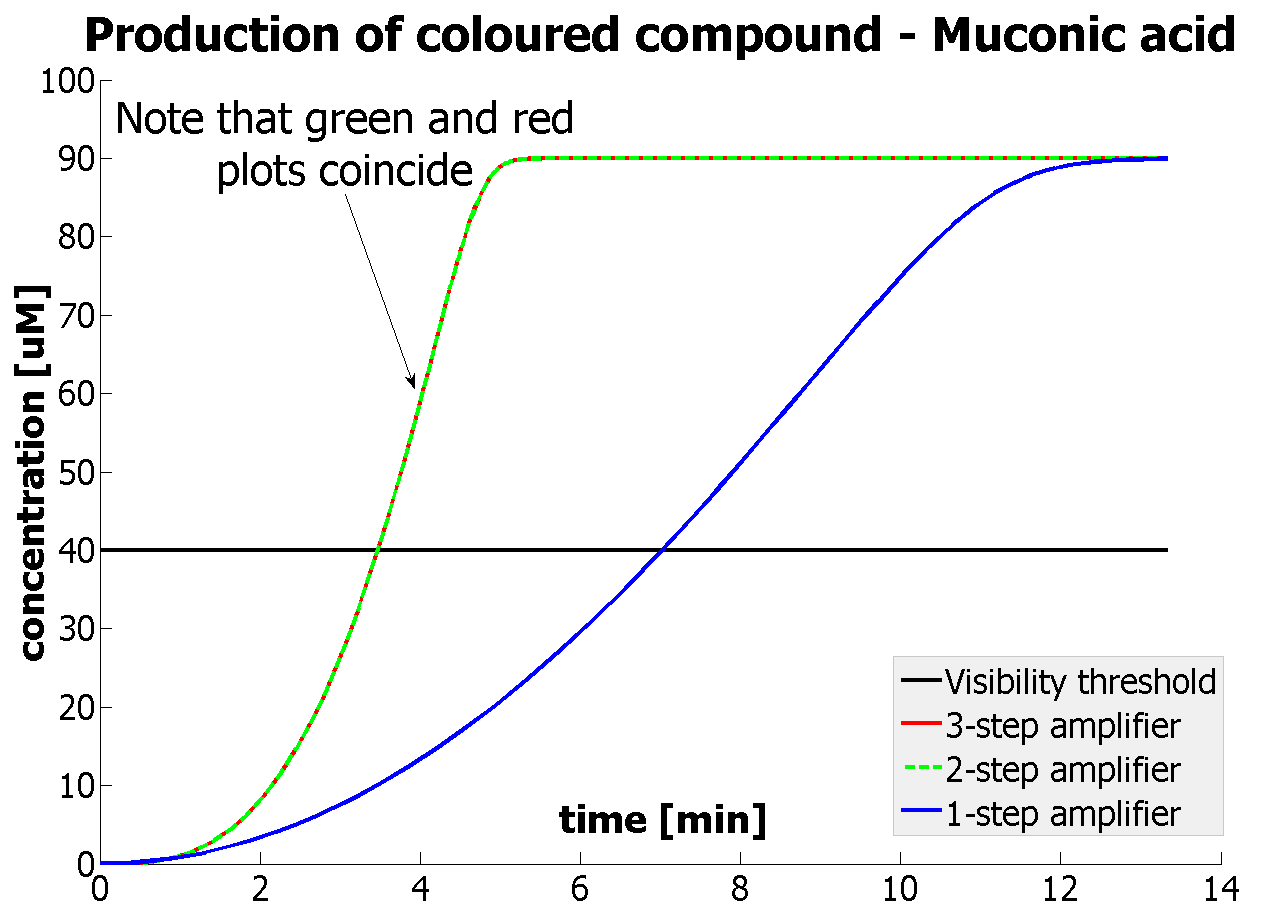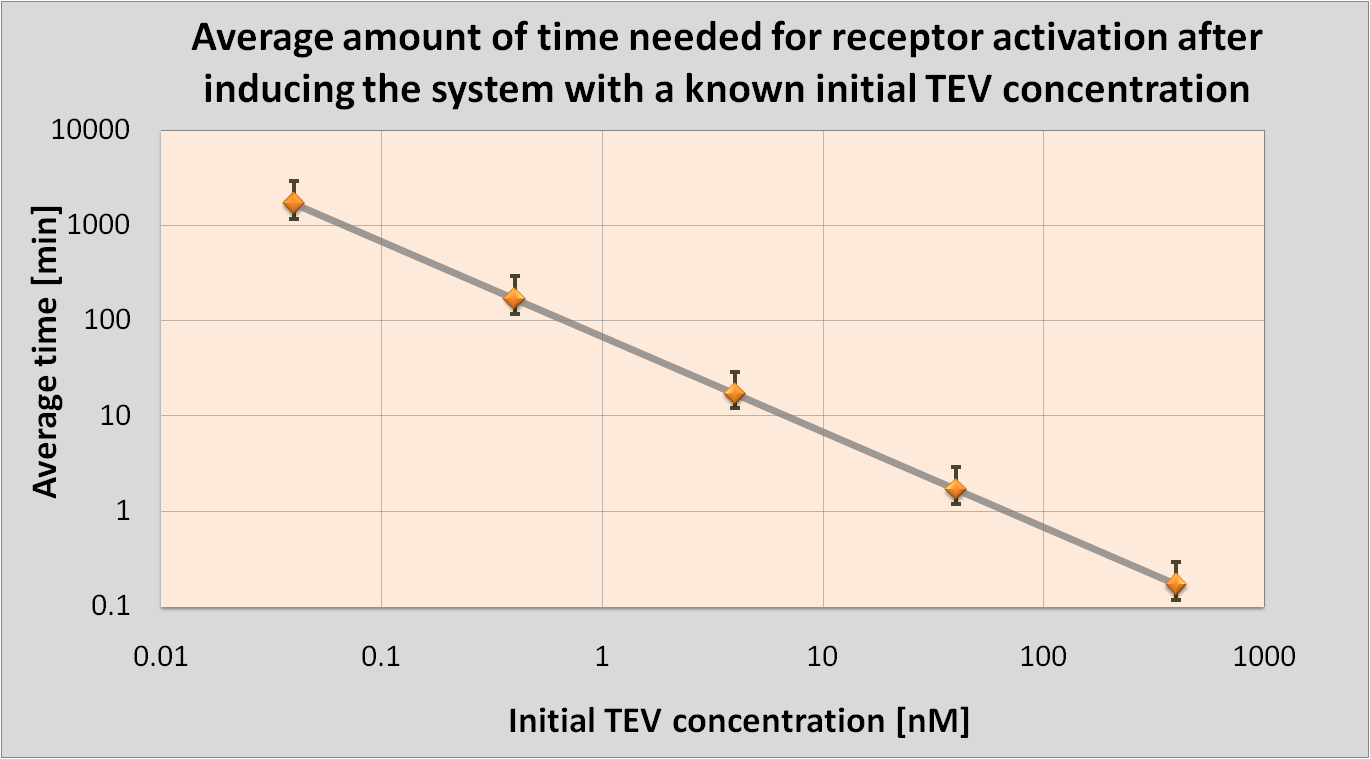Team:Imperial College London/Modelling
From 2010.igem.org
(Difference between revisions)
m |
|||
| Line 9: | Line 9: | ||
<ol> | <ol> | ||
<li><b>Output Amplification Model</b><br/>We came up with an idea of using the amplification of a colour output to make it show within minutes after the stimulus has been added. The question that arose was whether amplification will actually perform better than simple production in the cellular environment. Furthermore, we had trouble deciding whether we should design the amplification module to consist of 1,2 or even more amplification steps. These issues seemed to be difficult enough to employ modelling.</li> | <li><b>Output Amplification Model</b><br/>We came up with an idea of using the amplification of a colour output to make it show within minutes after the stimulus has been added. The question that arose was whether amplification will actually perform better than simple production in the cellular environment. Furthermore, we had trouble deciding whether we should design the amplification module to consist of 1,2 or even more amplification steps. These issues seemed to be difficult enough to employ modelling.</li> | ||
| + | <li><b>Signalling Module Model</b><br/> | ||
| + | Write here... | ||
| + | </li> | ||
<li><b>Surface Protein Model</b><br/>We came up with a novel idea of detecting organisms that we do not have a specific receptor for. In our particular example, the protease of Schistosoma was meant to cleave a protein displayed on the bacteria's cell wall. The cleaved peptide was supposed to be recognized by the receptor which would activate the colour expression. This solution raised questions about the risk of false positive or whether there are any chances for ComD receptors to be activated in the diluted environment. Modelling of this module would answer these questions.</li> | <li><b>Surface Protein Model</b><br/>We came up with a novel idea of detecting organisms that we do not have a specific receptor for. In our particular example, the protease of Schistosoma was meant to cleave a protein displayed on the bacteria's cell wall. The cleaved peptide was supposed to be recognized by the receptor which would activate the colour expression. This solution raised questions about the risk of false positive or whether there are any chances for ComD receptors to be activated in the diluted environment. Modelling of this module would answer these questions.</li> | ||
</ol> | </ol> | ||
| Line 17: | Line 20: | ||
|- | |- | ||
| - | |<b | + | |<b>Output Amplification Model</b><br/> |
<ol> | <ol> | ||
<li>It was shown that amplified systems easily outperform the simple production system (control) | <li>It was shown that amplified systems easily outperform the simple production system (control) | ||
| Line 34: | Line 37: | ||
</div> | </div> | ||
| + | <b>Signalling Module Model</b><br/> | ||
| + | Write here... | ||
| - | <b | + | <b>Surface Protein Model</b><br/> |
<ol> | <ol> | ||
<li>Initial TEV protease concentrations we determined for the optimal activation of the receptor within 1.5 minutes after elastases would have come into contact with our cell.</li> | <li>Initial TEV protease concentrations we determined for the optimal activation of the receptor within 1.5 minutes after elastases would have come into contact with our cell.</li> | ||
| Line 53: | Line 58: | ||
|- | |- | ||
| - | |<b | + | |<b>Output Amplification Model</b><br/> |
Goals: | Goals: | ||
<ol><p>This model was mainly developed in order to determine whether simple production is better than 1-, 2- or 3-step amplification.</p>Furthermore, an estimation of the speed of the response was desirable. | <ol><p>This model was mainly developed in order to determine whether simple production is better than 1-, 2- or 3-step amplification.</p>Furthermore, an estimation of the speed of the response was desirable. | ||
| Line 91: | Line 96: | ||
</ol> | </ol> | ||
| + | <b>Signalling Modelling Model</b><br/> | ||
| + | Write here... | ||
| - | <b | + | <b>Surface Protein Model</b><br/> |
Goals: | Goals: | ||
<ol><p>The aim of this model is to determine the concentration of Schistosoma elastase or TEV protease that should be added to the bacteria in order to trigger a response. This would allow us to correlate the required concentration for the activation with the concentration of Schistosoma elastase in the lake.<</p> | <ol><p>The aim of this model is to determine the concentration of Schistosoma elastase or TEV protease that should be added to the bacteria in order to trigger a response. This would allow us to correlate the required concentration for the activation with the concentration of Schistosoma elastase in the lake.<</p> | ||
Revision as of 10:38, 25 October 2010
| Modelling | Overview | Detection Model | Signaling Model | Fast Response Model | Interactions |
| A major part of the project consisted of modelling each module. This enabled us to decide which ideas we should implement. Look at the Fast Response page for a great example of how modelling has made a major impact on our design! | |
| Introduction to modelling |
In the process of designing our construct two major questions arose which could be answered by computer modelling:
|
| Results & Conclusions |
Output Amplification Model
Signalling Module Model Surface Protein Model
|
 "
"









